2019-05-30 - Nº 213
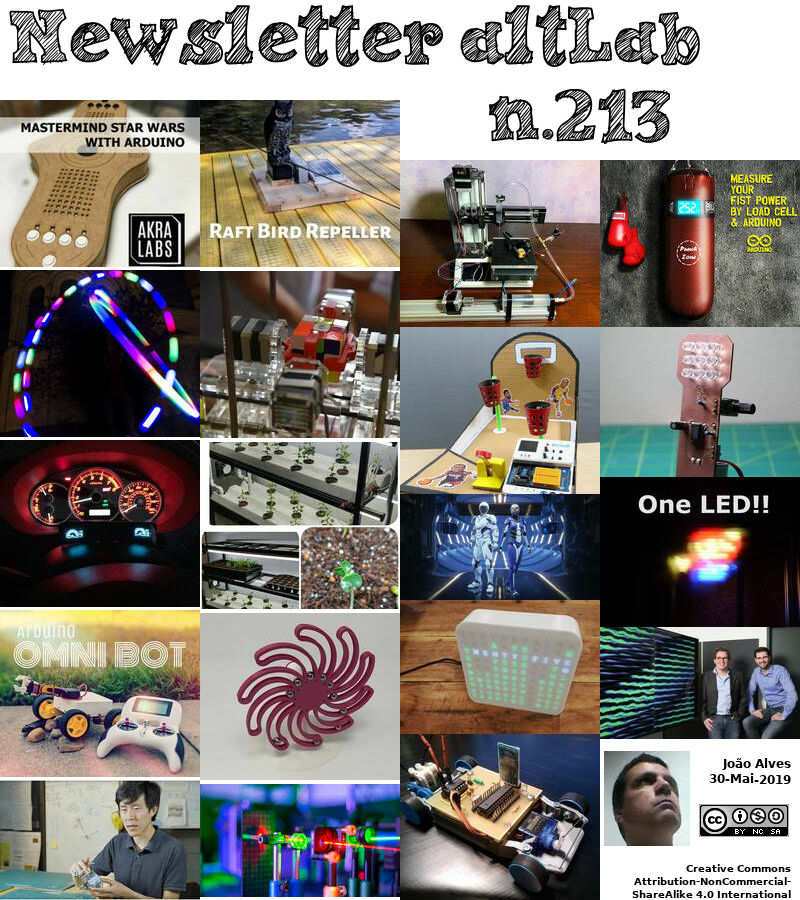
Editorial
Esta é a Newsletter Nº 213 que se apresenta com o mesmo formato que as anteriores. Se gostar da Newsletter partilhe-a!
Todas as Newsletters encontram-se indexadas no link.
Esta Newsletter tem os seguintes tópicos:
Faz hoje anos que nascia, em 1423, Georg von Peurbach. Este matemático e astrónomo austríaco promoveu o uso de algarismos arábicos (introduzido 250 anos antes no lugar dos numerais romanos), especialmente numa tabela de senos que ele calculou com precisão sem precedentes. Ele morreu antes que este projecto estivesse terminado e seu aluno, Regiomontanus, continuou até a sua própria morte. Peurbach era um seguidor da astronomia de Ptolomeu. Ele insistiu na realidade sólida das esferas de cristal dos planetas, indo um pouco além dos escritos de Ptolomeu. Ele calculou tabelas de eclipses em Tabulae Ecclipsium, observou o cometa de Halley em Junho de 1456 e o eclipse lunar de 3 de Setembro de 1457 de um local perto de Viena. Peurbach escreveu sobre astronomia, as suas observações e desenvolveu instrumentos astronómicos.
Faz também anos hoje que nascia, em 1908, Hannes Alfvén. Este astrofísico sueco foi um dos fundadores do campo da física dos plasmas (o estudo dos gases ionizados). Ele partilhou o Prémio Nobel de Física em 1970 (com o francês Louis Néel). Alfvén foi reconhecido “pelo trabalho fundamental em magneto-hidrodinâmica com aplicações notáveis em diferentes partes da física dos plasmas”. Ele concebeu a cosmologia do plasma como uma alternativa à teoria do Big Bang da origem do universo. No conceito de cosmologia do plasma, o universo não tem um começo específico nem tem um fim previsível. Em vez de um domínio por forças gravitacionais, a teoria sustenta que são as forças electromagnéticas do plasma em todo o universo que organizam a matéria do universo em sua estrutura observada de estrelas.
Faz igualmente anos hoje que nascia, em 1916, Joseph W. Kennedy. Este químico e físico norte-americano, foi um dos quatro co-descobridores do plutónio, (elemento 94) que foi produzido a partir de óxido de urânio bombardeado com deutério num ciclotron na Univ. da Califórnia em Berkeley. Posteriormente, em 28 de Março de 1941, Glenn Seaborg, Emilio Segrè e Joseph Kennedy demonstraram que o plutónio, como o U235, é fissionável com neutrões lentos, portanto neutrões de qualquer velocidade, o que implica que é um potencial material de bomba de fissão. Ele foi instrutor de química enquanto trabalhava no projecto de pesquisa liderado por Glenn Seaborg na Universidade da Califórnia, em Berkeley. Depois de trabalhar com a Seaborg, Kennedy foi escolhido por J. Robert Oppenheimer para liderar a Divisão de Química do Projecto Manhattan.
Por fim, faz anos hoje que nascia, em 1934, Aleksey Arkhipovich Leonov. Este cosmonauta russo, foi o primeiro homem a sair de uma nave espacial. Em 18 de Março de 1965, Voskhod 2 foi lançado ao espaço levando Leonov com Pavel Belyayev a bordo. Na segunda órbita, Leonov deixou a nave espacial através da fechadura à pressão enquanto ainda estava amarrada à nave. Ele fez filmes e praticou a movimentação fora da nave por 10 minutos. Voskhod 2 fez 17 órbitas a cerca de 177 km acima da terra. Dez anos depois, em 17 de Julho de 1975, Leonov comandou a nave Soyuz soviética, que estava em órbita com uma nave norte-americana Apollo.
Nesta semana que passou ficámos a saber que a SpaceX lançou 60 satélites Starlink do Space Launch Complex 40 (SLC-40) no Cabo Canaveral, na Florida. O Starlink da SpaceX é uma rede de satélites de última geração capaz de ligar o mundo, especialmente para aqueles que ainda não estão conectados, com serviços de Internet de banda larga confiáveis e acessíveis. O primeiro estágio do Falcon 9 para esta missão apoiou anteriormente a missão Telstar 18 VANTAGE em Setembro de 2018 e a missão Iridium-8 em Janeiro de 2019. Após a separação da primeira fase, a SpaceX pousou o primeiro estágio do Falcon 9 no navio “Of Course I Still Love You” que estava no Oceano Atlântico. Aproximadamente uma hora e dois minutos após o lançamento, os satélites Starlink foram posicionados a uma altitude de 440 km. Eles então usaram a propulsão a bordo para atingir uma altitude operacional de 550 km.
Também esta semana o rover Curiosity da NASA confirmou que a região em Marte que está a explorar, chamada de "unidade argilosa", é bem merecedora de seu nome. Duas amostras que o rover recentemente perfurou em zonas de rocha chamados "Aberlady" e "Kilmarie" revelaram as maiores quantidades de minerais de argila já encontradas durante a missão. Ambos os alvos de perfuração aparecem num novo selfie tirado pelo rover a 12 de Maio de 2019, o dia marciano, ou sol, da missão.
Nesta semana que passou também chegaram inúmeras novidades da Computex 2019 que se realiza em Taiwan e que termina no próximo dia 1 de Junho. A Intel apresentou a 10ª geração de processadores Intel Core e projecto Athena. A NVIDIA apresentou novas placas capazes de fazer ray-tracing em tempo-real possibilitando uma nova geração de jogos. A AMD voltou a fazer história com o anúncio de produtos de computação e gráficos de alto desempenho baseados em tecnologia de 7nm.
Na Newsletter desta semana apresentamos diversos projetos de maker. É apresentada a revista MagPI nº82 de Junho.
 João Alves ([email protected])
João Alves ([email protected])
O conteúdo da Newsletter encontra-se sob a licença  Creative Commons Attribution-NonCommercial-ShareAlike 4.0 International License.
Creative Commons Attribution-NonCommercial-ShareAlike 4.0 International License.
Novidades da Semana

Starlink Mission
"On Thursday, May 23 at 10:30 p.m. EDT SpaceX launched 60 Starlink satellites from Space Launch Complex 40 (SLC-40) at Cape Canaveral Air Force Station, Florida. SpaceX’s Starlink is a next-generation satellite network capable of connecting the globe, especially reaching those who are not yet connected, with reliable and affordable broadband internet services. Falcon 9’s first stage for this mission previously supported the Telstar 18 VANTAGE mission in September 2018 and the Iridium-8 mission in January 2019. Following stage separation, SpaceX landed Falcon 9’s first stage on the “Of Course I Still Love You” droneship, which was stationed in the Atlantic Ocean. Approximately one hour and two minutes after liftoff, the Starlink satellites were deployed at an altitude of 440km. They then used onboard propulsion to reach an operational altitude of 550km." [...]

NASA's Curiosity Mars Rover Finds a Clay Cache
"NASA's Curiosity rover has confirmed that the region on Mars it's exploring, called the "clay-bearing unit," is well deserving of its name. Two samples the rover recently drilled at rock targets called "Aberlady" and "Kilmarie" have revealed the highest amounts of clay minerals ever found during the mission. Both drill targets appear in a new selfie taken by the rover on May 12, 2019, the 2,405th Martian day, or sol, of the mission. This clay-enriched region, located on the side of lower Mount Sharp, stood out to NASA orbiters before Curiosity landed in 2012. Clay often forms in water, which is essential for life; Curiosity is exploring Mount Sharp to see if it had the conditions to support life billions of years ago. The rover's mineralogy instrument, called CheMin (Chemistry and Mineralogy), provided the first analyses of rock samples drilled in the clay-bearing unit." [...]
Outras Notícias
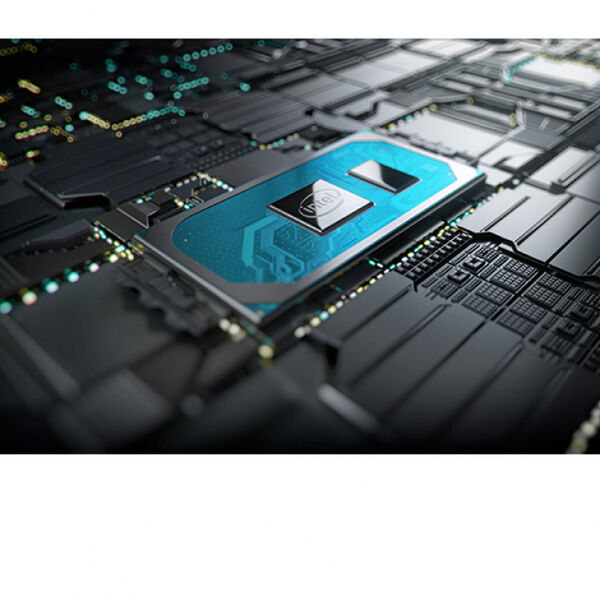
Intel Brings the Most Integrated Platform-Wide Leadership to PCs with New 10th Gen Intel Core Processors and Project Athena at COMPUTEX 2019
"Today at COMPUTEX 2019, Intel made a sweeping set of product and technology announcements, spanning the hottest segments of the PC industry. From new 10th Gen Intel Core processors and new details on Intel’s innovation program (code-named “Project Athena”) that will take mobile computing to an entirely new level, to the first-ever gaming processor with an all-core turbo of 5 GHz, Intel again raised the bar for PC experiences. “No one wants to compromise; people want it all: battery life, performance, responsiveness, connectivity and slick form factors. Our job is to come together as an industry and deliver incredible and differentiated PCs, purpose built to what real people want. 10th Gen Intel Core processors – our most integrated CPU – and Project Athena are great examples of how our deep investments at a platform level will help fuel innovation across the industry,” said Gregory Bryant, Intel senior vice president and general manager of the Client Computing Group. 10th Gen Intel Core Processors: Highly Integrated; Broad-Scale AI to the PC Intel announced the first 10th Gen Intel Core processors, bringing high-performance AI to the PC at scale with Intel® Deep Learning Boost (Intel DL Boost)." [...]

A Ray of Funshine: Computex 2019 Kicks Off Summer as Ray Tracing Sizzles
"When the summer sun crests, gamers know that more than tan lines are coming. They also know that means the next wave of PC gaming is just ahead from NVIDIA and game publishers. This year, gamers had their eyes trained on Computex in Taiwan, one of the world’s biggest annual tech trade shows, where many game trailers made their debut. Quake II AND Wolfenstein: Youngblood were among the AAA titles, cult classics, hot sequels and sizzling indie fare that made news in Taipei. And they’re all spiked with real-time ray tracing accelerated by NVIDIA GeForce RTX GPUs. Respect the Game." [...]
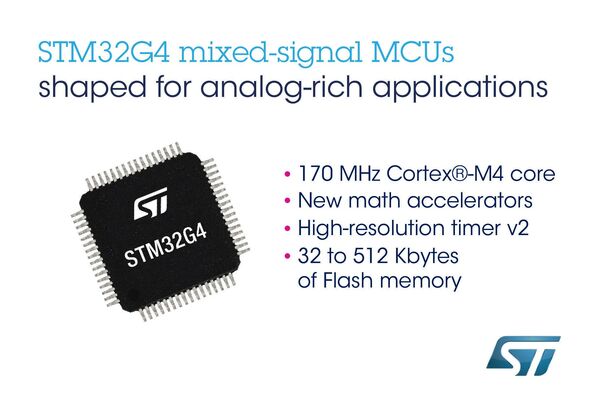
STMicroelectronics Raises Performance, Efficiency, and Security of Next-Generation Digital Power Applications with STM32G4 Microcontrollers
"As the latest smart electronic products add extra sensor-driven features and adopt higher-efficiency power technologies such as silicon carbide or gallium nitride to save energy, STMicroelectronics (NYSE: STM), a global semiconductor leader serving customers across the spectrum of electronics applications, has unleashed its next generation of microcontrollers with the performance to manage them. Targeted at advanced digital power applications and consumer and industrial appliances, the new STM32G4* microcontrollers introduce two new hardware mathematical accelerators to boost processing of applications using Cordic[1] and Filtering functions among a range of features to support increased performance and energy efficiency. Dedicated to speeding calculations such as trigonometry for energy-saving motor controls in appliances or air conditioners and filtering for signal conditioning or digital power control, the accelerators compute results faster and more efficiently than the general-purpose main processor. This offloading also frees the core to receive more sensor data and control additional user functions. Further new features include higher-resolution power conversion timers with various built-in functions that offload the CPU and ease developers’ lives. There are also higher-performing analog peripherals and converters, ultra-speed connections for lightning-fast response to external events, and support for the latest USB-C interface with Power Delivery that allows fast charging or conveniently powering devices up to 100W." [...]
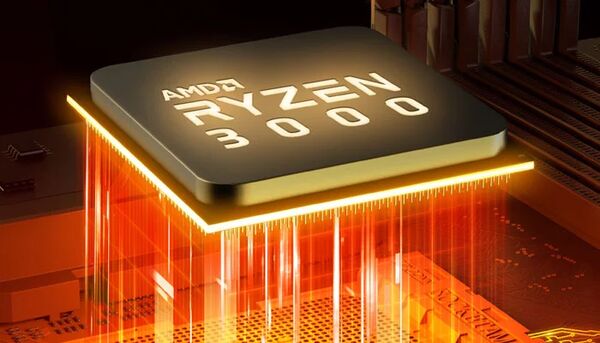
AMD Announces Next-Generation Leadership Products at Computex 2019 Keynote
"AMD today again made technology history with the announcement of high-performance 7nm-based computing and graphics products that are expected to deliver new levels of performance, features and experiences for PC gamers, enthusiasts and content creators. During the first-ever Computex opening keynote, AMD President and CEO Dr. Lisa Su announced: The new “Zen 2” core widely outperforms the historical generational performance improvement industry trend, up to 15% estimated instructions per clock (IPC)2 uplift over the predecessor “Zen” architecture. The “Zen 2” CPU core powering the next-generation AMD Ryzen and EPYC™ processors also includes significant design improvements including larger cache sizes and a redesigned floating point engine. The 3rd Gen AMD Ryzen desktop processor family, including the new 12-core Ryzen 9 processor, offers leadership performance.1 The AMD X570 chipset for socket AM4, the world’s first PCIe 4.0 supported chipset with more than 50 new motherboards at launch. RDNA gaming architecture designed to drive the future of PC gaming, console, and cloud, anticipated to deliver incredible performance, power, and memory efficiency in a smaller package. The 7nm AMD Radeon RX 5700-series gaming graphics card family featuring high-speed GDDR6 memory and support for the PCIe 4.0 interface." [...]
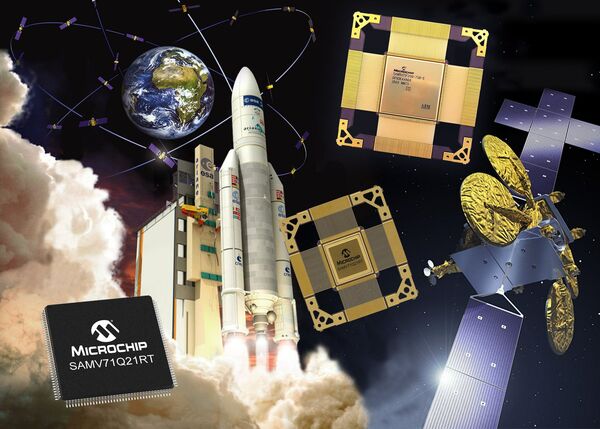
Scale Space Applications with COTS-to-Radiation-Tolerant and Radiation-Hardened Arm® Core MCUs
"Devices enable designers to begin development with a commercial device before moving to different levels of radiation-qualified versions, reducing development time and costs From NewSpace to critical space missions, designers of space applications need to reduce design cycles and costs while scaling development across missions with different radiation requirements. To support this trend, Microchip Technology Inc. (Nasdaq: MCHP) today introduced the space industry’s first Arm®-based microcontrollers (MCUs) that combine the low-cost and large ecosystem benefits of Commercial Off-the-Shelf (COTS) technology with space-qualified versions that have scalable levels of radiation performance. Based on the automotive-qualified SAMV71, the SAMV71Q21RT radiation-tolerant and SAMRH71 radiation-hardened MCUs implement the widely deployed Arm® Cortex®-M7 System on Chip (SoC), enabling more integration, cost reduction and higher performance in space systems. The SAMV71Q21RT and SAMRH71 allow software developers to begin implementation with the SAMV71 COTS device before moving to a space-grade component, significantly reducing development time and cost. Both devices can use the SAMV71’s full software development toolchain, as they share the same ecosystem including software libraries, Board Support Package (BSP) and Operating System (OS) first level of porting. Once preliminary developments are complete on the COTS device, all software development can be easily swapped out to a radiation-tolerant or radiation hardened version in a high-reliability plastic package or space-grade ceramic package." [...]

Alaka’i Technologies Launches World’s First Hydrogen-Powered Air Mobility System
"Today, Alaka’i Technologies unveiled Skai, the world’s first hydrogen fuel cell powered air mobility solution designed to transform the way the world moves. From its sleek, uncluttered design, radically simple and safe electric vertical takeoff and landing (eVTOL) vehicle, to its fuel source - a system that runs entirely on hydrogen fuel cells - Skai is poised to be one of the safest, cleanest and most versatile air mobility solutions introduced to the world. Skai’s core team members are nationally-recognized aerospace experts, engineers, and veteran pilots who have served in top-level positions at NASA, Raytheon, Beech, Cirrus, Dayjet, and the Department of Defense who collaborated on the vision of solving some of the world’s most-pressing global challenges across transportation, energy and the environment. Skai is co-designed by Designworks, the design innovation studio for the BMW Group, to leverage its creative expertise to help shape a world-class vehicle. The result is Skai, stripped away of all unnecessary complexity, waste and possible points of failure, leaving the most essential elements for the craft and optimizing them for the most intuitive experience. “This remarkably impressive team have come together to build on our collective experience to finally realize our singular, critical vision to launch Skai and transform transportation,” said Brian Morrison, Co-Founder, President and Chief Technology Officer of Alaka’i Technologies." [...]

Investing in Australia’s Connectivity and Digital Economy
"Over the last three years, Google has invested US$47 billion (approx. A$67.8 billion) in CAPEX to improve our infrastructure globally. Today we’re happy to announce that the INDIGO cable system, which connects Sydney, Perth and Singapore, is ready for service! Developed in partnership with AARnet, Indosat, Singtel, SubPartners and Telstra, INDIGO will strengthen connectivity between Australia and Southeast Asia, boosting business capabilities within the region. It will enable better internet connectivity, meaning faster and more reliable services for all of our users. When combined with our Cloud Regions in Sydney and Singapore, INDIGO will play a major role in supporting Google Cloud customers in Asia Pacific." [...]

Loon balloons are now connecting users in Peru
"During testing in preparation for commercial service, a magnitude 8.0 earthquake hit the Amazon region and Loon responded in 48 hours Over the past few months, we have been in negotiations with Telefónica on a commercial contract that would utilize Loon’s balloons to extend mobile internet access to unserved and underserved areas of Peru, specifically remote parts of the Amazon region. In the past month, these efforts had accelerated to the point where we had begun installing infrastructure and intermittently testing with balloons serving LTE over the region. The progress was very encouraging. On Sunday morning, a magnitude 8.0 earthquake struck the region. After requests from the government of Peru and Telefónica, we quickly re-directed a group of balloons to the impacted area. Early Tuesday morning, the first balloons arrived and began serving LTE to users below." [...]
Ciência e Tecnologia

Artificial Intelligence Improves Power Transmission
"To integrate the usually volatile renewable sources into energy supply, capacities of the power grid have to be increased. The need for new lines can be reduced by better utilization of existing lines as a function of weather conditions. To this end, researchers of Karlsruhe Institute of Technology (KIT) work on self-learning sensor networks to model the cooling effect of weather based on real data within the “PrognoNetz” project. In case of favorable conditions, the line’s power transmission can be enhanced in this way. Rapid extension of the use of renewable energy sources – wind energy in the north, photovoltaics in the south – and the increasing international power trade result in increasing requirements on the power transmission grid. To transport power from producers to consumers, to prevent temporary shutdown of plants that generate power from regenerative sources in particular at high wind intensities, and to ensure high supply security in general, considerable extension of the existing grid infrastructure appears to be required." [...]
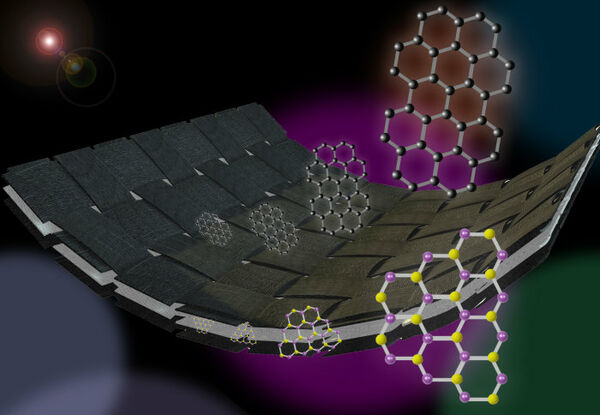
Washable, wearable battery-like devices could be woven directly into clothes
"Researchers have developed washable, wearable ‘batteries’ based on cheap, safe and environmentally friendly inks and woven directly into fabrics. The devices could be used for flexible circuits, healthcare monitoring, energy conversion, and other applications. The team, led by Dr Felice Torrisi, who recently joined Imperial from the University of Cambridge, have shown how graphene – an atom-thick sheet of carbon – and other related materials can be directly incorporated into fabrics. Within the fabric, the materials produce charge storage elements such as capacitors, paving the way to textile-based power supplies which are washable, flexible and comfortable to wear. The research, published in the journal Nanoscale, demonstrates that graphene inks can be used in textiles able to store electrical charge and release it when required. The new textile electronic devices are based on low-cost, sustainable and scalable dyeing of polyester fabric." [...]

Carnegie Mellon Researchers Create Soft, Flexible Materials with Enhanced Properties
"A team of polymer chemists and engineers from Carnegie Mellon University have developed a new methodology that can be used to create a class of stretchable polymer composites with enhanced electrical and thermal properties. These materials are promising candidates for use in soft robotics, self-healing electronics and medical devices. The results are published in the May 20 issue of Nature Nanotechnology. In the study, the researchers combined their expertise in foundational science and engineering to devise a method that uniformly incorporates eutectic gallium indium (EGaIn), a metal alloy that is liquid at ambient temperatures, into an elastomer. This created a new material — a highly stretchable, soft, multi-functional composite that has a high level of thermal stability and electrical conductivity Carmel Majidi, a professor of Mechanical Engineering at Carnegie Mellon and director of the Soft Machines Lab, has conducted extensive research into developing new, soft materials that can be used for biomedical and other applications. As part of this research, he developed rubber composites seeded with nanoscopic droplets of liquid metal." [...]
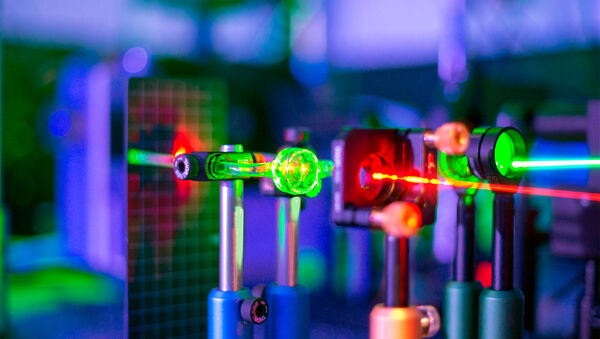
Quantum computing boost from vapour stabilising technique
"The patented technique allows electrons to be used for quantum computing, high-precision measurements and other applications. A technique to stabilise alkali metal vapour density using gold nanoparticles, so electrons can be accessed for applications including quantum computing, atom cooling and precision measurements, has been patented by scientists at the University of Bath. Alkali metal vapours, including lithium, sodium, potassium, rubidium and caesium, allow scientists to access individual electrons, due to the presence of a single electron in the outer ‘shell’ of alkali metals. This has great potential for a range of applications, including logic operations, storage and sensing in quantum computing, as well as in ultra-precise time measurements with atomic clocks, or in medical diagnostics including cardiograms and encephalograms. However, a serious technical obstacle has been reliably controlling the pressure of the vapour within an enclosed space, for instance the tube of an optical fibre. The vapour needs to be prevented from sticking to the sides in order to retain its quantum properties, but existing methods to do this, including directly heating vapour containers are slow, costly, and impractical at scale." [...]

Tapping the power of AI and high-performance computing to extend evolution to superconductors
"Materials by design: Argonne researchers use genetic algorithms for better superconductors. Owners of thoroughbred stallions carefully breed prizewinning horses over generations to eke out fractions of a second in million-dollar races. Materials scientists have taken a page from that playbook, turning to the power of evolution and artificial selection to develop superconductors that can transmit electric current as efficiently as possible. Perhaps counterintuitively, most applied superconductors can operate at high magnetic fields because they contain defects. The number, size, shape and position of the defects within a superconductor work together to enhance the electric current carrying capacity in the presence of a magnetic field. Too many defects, however, can lead to blocking the electric current pathway or a breakdown of the superconducting material, so scientists need to be selective in how they incorporate defects into a material." [...]
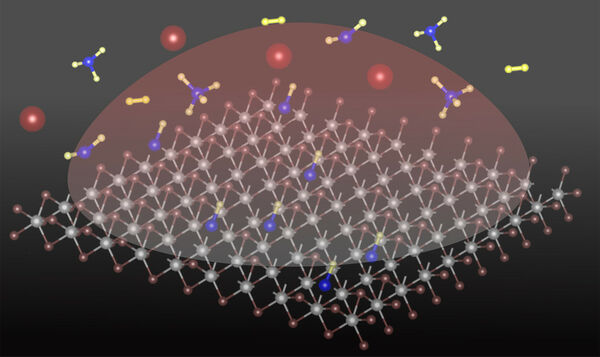
Adding a carbon atom transforms 2D semiconducting material
"A technique that introduces carbon-hydrogen molecules into a single atomic layer of the semiconducting material tungsten disulfide dramatically changes the electronic properties of the material, according to Penn State researchers who say they can create new types of components for energy-efficient photoelectric devices and electronic circuits with this material. “We have successfully introduced the carbon species into the monolayer of the semiconducting material,” said Fu Zhang, doctoral student in materials science and engineering and lead author of a paper published online today (May 24) in Science Advances. Prior to doping — adding carbon — the semiconductor, a transition metal dichalcogenide (TMD), was n-type — electron conducting. After substituting carbon atoms for sulfur atoms, the one-atom-thick material developed a bipolar effect, a p-type — hole — branch, and an n-type branch. This resulted in an ambipolar semiconductor. “The fact that you can change the properties dramatically by adding as little as two atomic percent was something unexpected,” said Mauricio Terrones, senior author and distinguished professor of physics, chemistry, and materials science and engineering." [...]
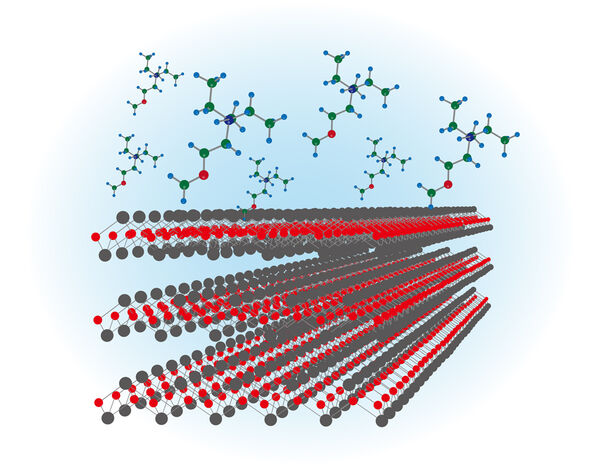
Superconductor films convert heat into electricity
"Films of a superconductor show excellent thermoelectric properties at very low film thicknesses When thinned down to a sheet a few atoms thick, the superconductor iron selenide (FeSe) can efficiently convert heat into electricity, researchers at RIKEN have discovered1. This opens up the possibility that similar multifunctionality may be lurking in other two-dimensional materials. Ultrathin films often behave quite differently from the same material in bulk form. For example, bulk FeSe superconducts at temperatures below 8 kelvin (−265 degrees Celsius), whereas a single-atom layer of FeSe superconducts at 65 kelvin. This is surprising since the conductivity of semiconductors usually drops the thinner they become. Sunao Shimizu, who was working at the RIKEN Center for Emergent Matter Science (CEMS) at the time of the study, along with his CEMS colleagues and other collaborators, has now found that in addition to high-temperature superconductivity, ultrathin films of FeSe exhibit excellent thermoelectric properties." [...]

A novel theory of heat, in the search for efficient thermoelectrics
"EPFL and MARVEL researchers have developed a new theory for heat conduction that can finally describe and predict the thermal conductivity of any insulating material. This new formulation will let scientists make accurate predictions of thermal conductivity in a range of materials for critical engineering applications – from electronics to lasers to waste-heat recovery. Thermoelectric materials in particular hold vast potential for use in energy applications because they generate electricity from waste heat, such as that generated by industrial processes, by car and truck engines, or simply by the sun. Reducing the thermal conductivity of these materials by a factor of three, for example, would completely revolutionize existing waste-heat recovery, and also all refrigeration and air-cooling technology. A unique theory for all insulating materials In the paper Unified theory of thermal transport in crystals and glasses, out in Nature Physics, Michele Simoncelli, a PhD student at EPFL’s Theory and Simulation of Materials (THEOS) Laboratory – together with Nicola Marzari, a professor at EPFL’s School of Engineering and head of THEOS and of the MARVEL NCCR, and Francesco Mauri, a professor at the University of Rome–Sapienza – present a novel theory that finally decodes the fundamental, atomistic origin of heat conduction. Up to now, different formulations needed to be used depending on the systems studied (e.g., ordered materials, like a silicon chip, or disordered, like in a glass), and there wasn’t a unified picture covering all possible cases." [...]

EPFL researchers crack an enduring physics enigma
"Researchers from EPFL have found the mechanism that lies behind a mysterious physics phenomenon in fluid mechanics: the fact that turbulence in fluids spontaneously self-organizes into parallel patterns of oblique turbulent bands – an example of order emerging spontaneously from chaos. In so doing, they solved a problem that had stumped generations of physicists. For decades, physicists, engineers and mathematicians failed to explain a remarkable phenomenon in fluid mechanics: the natural tendency of turbulence in fluids to move from disordered chaos to perfectly parallel patterns of oblique turbulent bands. This transition from a state of chaotic turbulence to a highly structured pattern was observed by many scientists, but never understood. At EPFL's Emerging Complexity in Physical Systems Laboratory (School of Engineering), Tobias Schneider and his team have identified the mechanism that explains this phenomenon. Their findings have been published in Nature Communications." [...]

Engineers Boost Potential for Creating Successor to Shrinking Transistors
"Computers and similar electronic devices have gotten faster and smaller over the decades as computer-chip makers have learned how to shrink individual transistors, the tiny electrical switches that convey digital information. Scientists’ pursuit of the smallest possible transistor has allowed more of them to be packed onto each chip. But that race to the bottom is almost over: Researchers are fast approaching the physical minimum for transistor size, with recent models down to about 10 nanometers — or just 30 atoms — wide. “The processing power of electronic devices comes from the hundreds of millions, or billions, of transistors that are interconnected on a single computer chip,” said Dr. Kyeongjae Cho, professor of materials science and engineering at The University of Texas at Dallas. “But we are rapidly approaching the lower limits of scale.” To extend the quest for faster processing speed, the microelectronics industry is looking for alternative technologies. Cho’s research, published online April 30 in the journal Nature Communications, might offer a solution by expanding the vocabulary of the transistor." [...]

Quantum information gets a boost from thin-film breakthrough
"Efforts to create reliable light-based quantum computing, quantum key distribution for cybersecurity, and other technologies got a boost from a new study demonstrating an innovative method for creating thin films to control the emission of single photons. “Efficiently controlling certain thin-film materials so they emit single photons at precise locations—what’s known as deterministic quantum emission—paves the way for beyond-lab-scale quantum materials,” said Michael Pettes, a Los Alamos National Laboratory materials scientist and leader of the multi-institution research team. The scalability of these two-dimensional, tungsten/selenium thin films makes them potentially useful in processes to manufacture quantum technologies. Single-photon generation is a requirement for all-optical quantum computing and key distribution in quantum communications, and it is crucial for advancing quantum information technologies. The project, documented as a Featured Article in the journal Applied Physics Letters this week, exploits strain at highly spatially localized and well-separated emission sites, or tips, in a tungsten/selenium film. The team synthesized the film through chemical vapor deposition using a multi-step, diffusion-mediated gas source." [...]
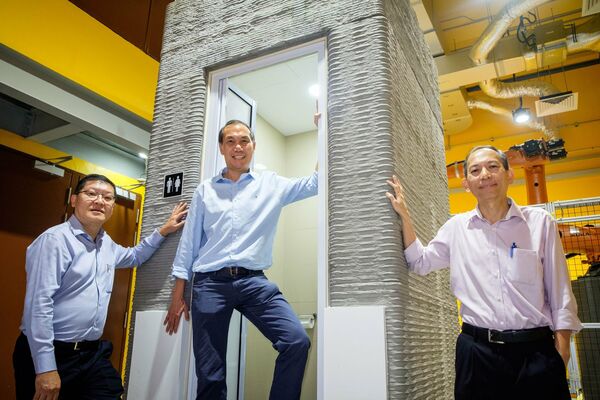
NTU Singapore develops technology that can 3D-print a bathroom unit within a day
"Innovation developed in partnership with Sembcorp Design and Construction, and Sembcorp Architects & Engineers Researchers from Nanyang Technological University, Singapore (NTU Singapore) have developed the capability to 3D print an unfurnished bathroom in less than a day. After printing, the bathroom is furnished with toilet fittings to become a pre-fabricated unit, ready for use in construction projects. Its interior includes a sink, mirror, shower, toilet bowl, ceramic tiled walls and flooring, complete with concealed drains and piping. This could potentially help firms build prefabricated bathroom units (PBU) about 30 per cent more quickly and 30 per cent lighter than current PBUs. In the past four years, the research team focused on developing a special concrete mix which is fluid enough to flow through the hoses and print nozzle, yet can harden fast enough so that the next layer is able to be printed on it. On top of ensuring a consistent print quality, the final product also has to be as strong as conventional concrete." [...]
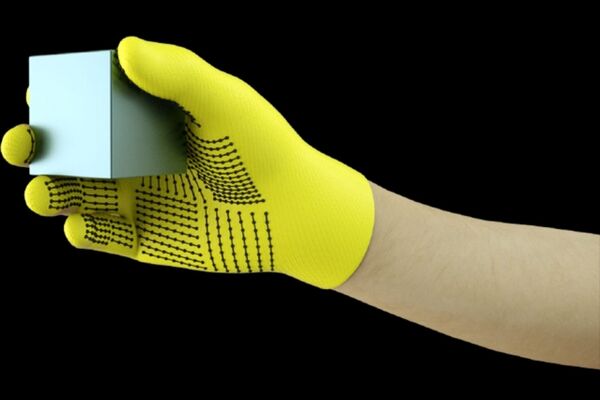
Sensor-packed glove learns signatures of the human grasp
"Signals help neural network identify objects by touch; system could aid robotics and prosthetics design. Wearing a sensor-packed glove while handling a variety of objects, MIT researchers have compiled a massive dataset that enables an AI system to recognize objects through touch alone. The information could be leveraged to help robots identify and manipulate objects, and may aid in prosthetics design. The researchers developed a low-cost knitted glove, called “scalable tactile glove” (STAG), equipped with about 550 tiny sensors across nearly the entire hand. Each sensor captures pressure signals as humans interact with objects in various ways. A neural network processes the signals to “learn” a dataset of pressure-signal patterns related to specific objects." [...]
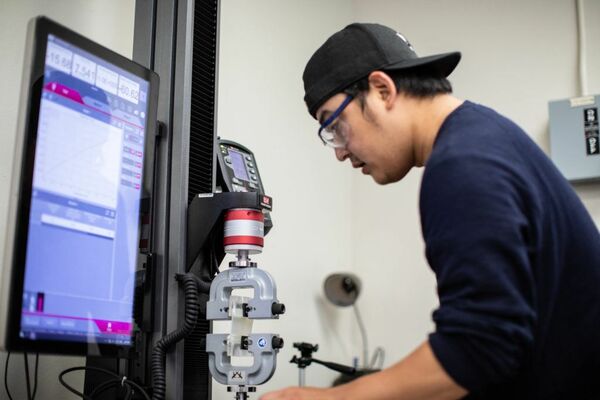
Lights, Camera, Fracture
"Stretchable electronics are where engineering meets Hollywood special effects. With a wide range of healthcare, energy and military applications, stretchable electronics are revered for their ability to be compressed, twisted and conformed to uneven surfaces without losing functionality. By using the elasticity of polymers such as silicone, these emerging technologies are made to move in ways that mimic skin. This sheds light on why Smooth-On Ecoflex, a substance most commercially used to create molds and movie masks and prosthetics, is the most prominent silicone elastomer (a rubber-like substance) found in research. While handling a sample of the material, Dr. Matt Pharr, assistant professor in the J. Mike Walker ’66 Department of Mechanical Engineering at Texas A&M University, and graduate student Seunghyun Lee, recently discovered a new type of fracture. “I have done some work in the area of stretchable electronics, so I have a lot of materials from when I was a postdoc." [...]
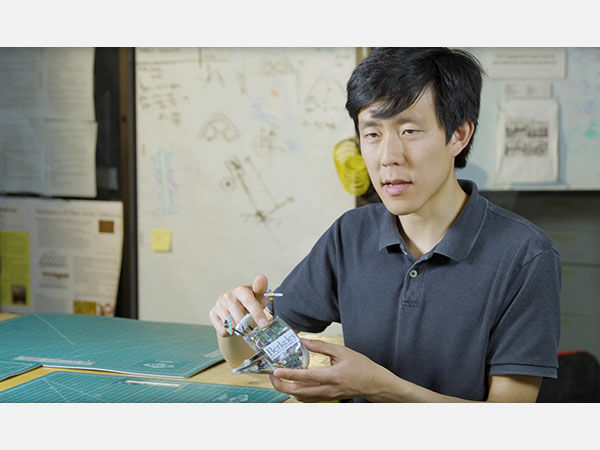
Army project develops agile scouting robots
"In a research project for the U.S. Army, researchers at the University of California, Berkeley developed an agile robot, called Salto that looks like a Star Wars Imperial walker in miniature and may be able to aid in scouting and search-and-rescue operations. Robots like this may one day be used to save lives of both warfighters and civilians, researchers said. Topping out at less than a foot, Salto, which stands for saltatorial (leaping like a grasshopper) locomotion on terrain obstacles, now has a sophisticated control systems that allows it to master increasingly complex tasks, like bouncing in place, navigating an obstacle course or following a moving target, all controlled with a radio controller. In 2016, the research team demonstrated how Salto could take a leap and then immediately spring higher by ricocheting off a wall, making it the world's most vertically agile robot - jumping for than three times its height. With its new capabilities, the researchers hope Salto will propel the development of small, nimble robots that could leap through rubble to aid in search-and-rescue and other military missions. "The physical environment the Army operates in is highly irregular, cluttered, and constantly changing," said Dr. Samuel Stanton, program manager at Army Research Office, an element of U.S. Army Combat Capability Development Command's Army Research Laboratory." [...]
Documentação
A documentação é parte essencial do processo de aprendizagem e a Internet além de artigos interessantes de explorar também tem alguma documentação em formato PDF interessante de ler. Todos os links aqui apresentados são para conteúdo disponibilizado livremente pelo editor do livro.
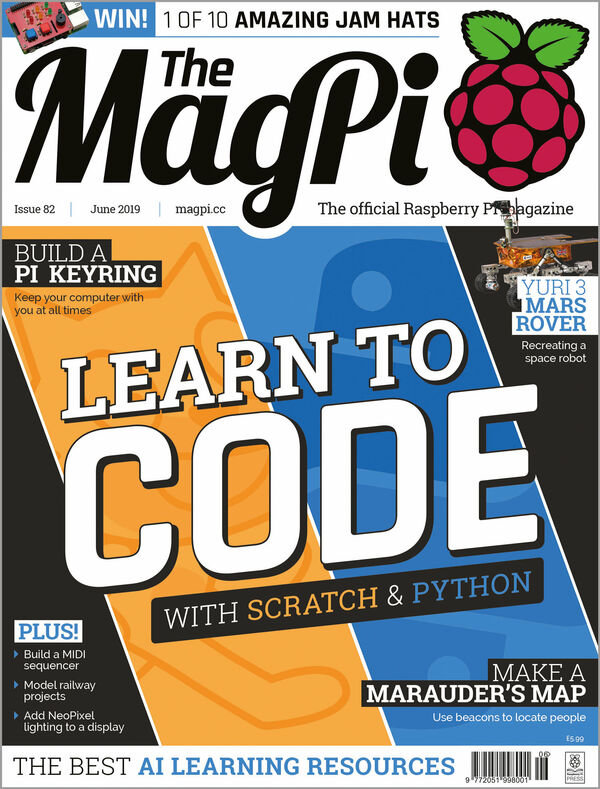
The MagPI 82
"Learn to code with Scratch and Python in this month’s edition of The MagPi. Scratch and Python tag-team in the world of computing education. Scratch makes it easy to grasp the coding basics in a colourful interface; Python is an ultra-modern language: easy to pick up and powerful enough to make you a coding master. Sean McManus is a prolific author of coding books. This month he’s going to show our readers how to code a Raspberry Pi. Plus!" [...]
Projetos Maker
Diversos Projetos interessantes.
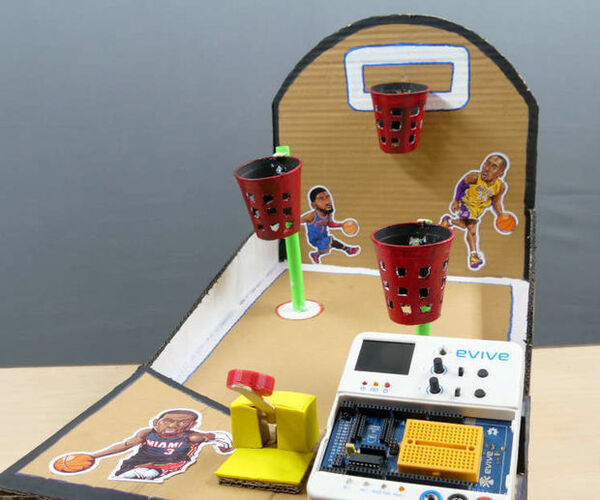
Smart Basketball Arcade Game With Score Counting Hoops Using Evive- Arduino Embedded Platform
"Of all the games out there, the most entertaining are arcades games. So, we thought why not make one ourselves at home! And here we are, the most entertaining DIY game you'd have ever played until now - the DIY Arcade Basketball Game! Not only is this game super fun to play but also super duper fun to make! With step-by-step instructions and easy programming in PictoBlox - a graphical programming software with advanced capabilities, this game is going to be the best game you will ever play! So what are you still doing here?" [...]
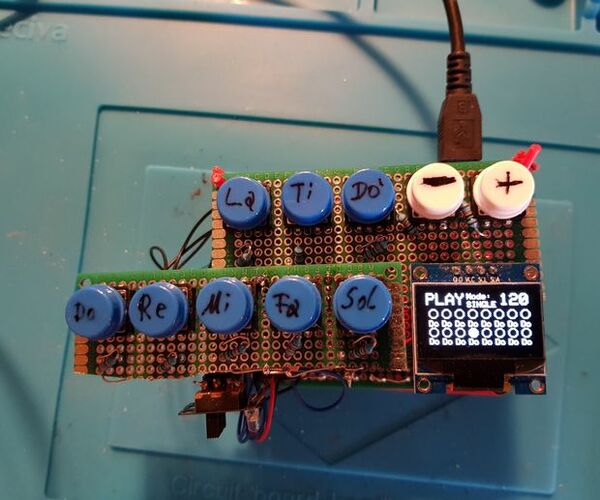
DoReMiQuencer - Programmable MIDI Sequencer With Keyboard
"This device was created for use with VCVRack, a virtual modular synthesizer created by VCV, but can serve as a general purpose MIDI controller. It serves as a MIDI sequencer or keyboard, depending on the selected mode. The MIDI notes mapped to the keys are Do, Re, Mi, Fa, Sol, La, Ti, Do', hence the name. In sequencer mode, it loops through 16 programmed notes in either 'single' or 'continous' mode, selectable via switch. To program a sequence, the device needs to be switched into 'record' mode, where pressing the note buttons creates the sequence. Of course, the device can be customized to suit your needs and is designed in a modular way for that reason." [...]

Build a Digital Weight Scale & Force Guage W/ Arduino & Loadcell
"Overview In this tutorial, you will learn about the load cell module, its applications and its operation. Also, youll see how to use the load cell module with Arduino. Then after learning about calibrating the load cell, you will create a digital scale that can measure the weight with an accuracy of 0.0001 grams and also a force gauge. What You Will Learn: What load cell is and how it works How to use the load cell module with Arduino Build a digital scale with Arduino Use a load cell as force gauge" [...]
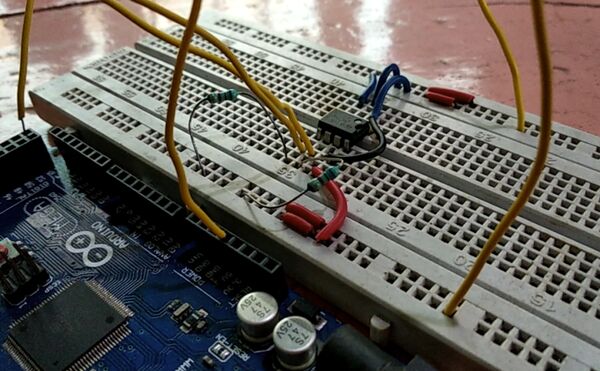
Using I2C EEPROM ST24C04 with Arduino IDE
"Recently , I got hold of this EEPROM IC while browsing online , I searched the web and I found out that the IC, having part number ST24C04 supported I2C communication which gave me excitement thinking that I could make this work using an Arduino ! For those who are unaware, an EEPROM stands for Electrically Erasable Programmable Read Only Memory. It is non-volatile and can store information even after being powered off. Essentially it behaves like a tiny hard disk which opens the gate to many Arduino projects that requires data storage like logging configuration data, storing weather data , or even storing passwords ! Just imagine if you could use your own encryption techniques to store passwords of all your social media accounts in an EEPROM that does not lose the data or is prone to getting hacked. Guess what , it is definitely possible with this IC." [...]

Jacket for Visually Impaired
"Design of assistance to the visually impaired with removable prototype to be used in any clothes and powered by the cell phone. Visual deficiency is characterized by the limitation or loss of the basic functions of the eye and visual system. The visually impaired may be the blind or low vision person. To help people with this deficiency we study and every day we develop something to assist our brothers, this time we made a prototype that can be fixed on any clothing and will serve as a friend, warning the handicapped of objects in front of him, with that the user is not limited to just a single outfit with this technology. To run this project we use the Arduino Lilypad board, with a little creativity and an easy and affordable programming the project worked and we are here posting to share the solution to the Arduino community. " [...]

Edge-Lit Seven Segment Display
"Seven segment displays have been around for more than a century (https://en.wikipedia.org/wiki/Seven-segment_display) and form the familiar shape of the numbers in digital watches, instrument panels and many other numerical displays. They’ve been replaced in many cases by screens, but from an efficiency standpoint it’s hard to argue with the brevity of encoding the state of a numerical display in only 7 bits of information (each segment on or off) Most seven-segment displays are monochrome, so this edge-lit version adds visual interest by using the full color capabilities of cheap RGB LED strips to illuminate each digit and even each segment (or even half-segment) of the display in a different color. Embedding the clear acrylic segments in a larger acrylic frame allows you to see completely through the entire display, which another unique aspect of this project. This build combines small dozens of small laser-cut acrylic pieces which fit together with very tight tolerances. It uses skinny (4mm wide) LED strips which must be soldered, bent, and then slotted in between those acrylic pieces. When assembling the parts you must be willing to force pieces into place, even though it feels like you are stressing the brittle acrylic." [...]
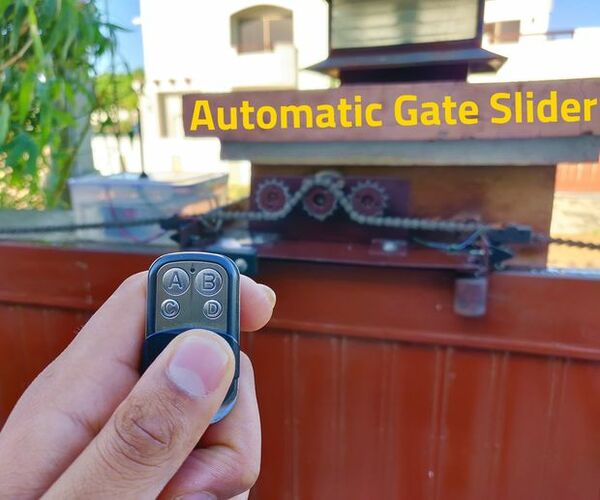
Automatic Gate Slider Under $100
"Over the summer, my dad motivated me to look into buying a gate automation system and setting it up. So I started my research and looked into package solutions on AliExpress and local vendors. The local vendors were offering complete solutions including installation for > $1000. These were Italian systems and were supposed to be very high quality. But the price was way out of our budget. The systems on AliExpress were also pretty expensive, the cheapest one being $500 before taxes." [...]
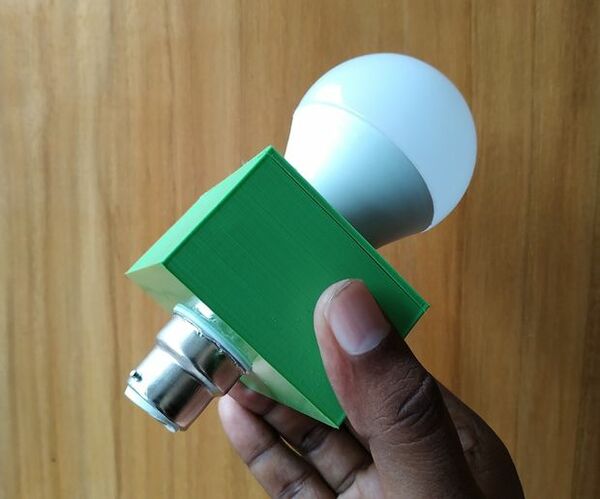
$3 Smart Bulb Holder
"Most of the time I realized the necessity of controlling my room light from my bed. I can replace the bulb with a smart bulb but they are expensive. Some cheap solution is available using remote control but for this solution, I need to change or modify the switchboard. I don't like to do this because I am lazy and like to keep lazy. Suddenly I discover the smart bulb holder which can convert any lamp to smart lamp and does not require any connection change. I am sorry, these are also expensive." [...]
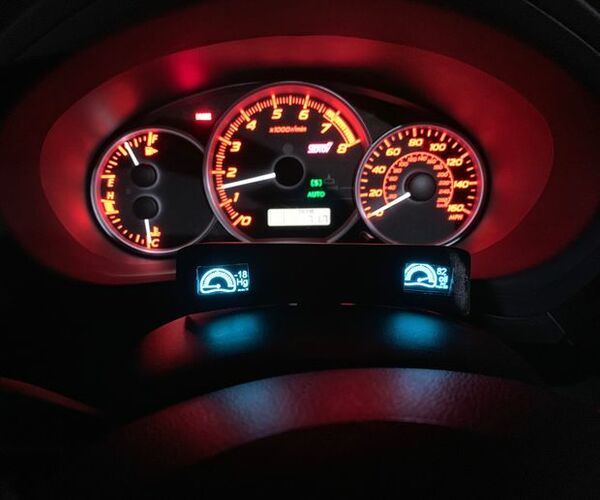
Wifi Enabled OLED ESP32 Car Gauges
"Introductions first I build car gauges as a sort of on again and off again hobby. See https://www.instructables.com/id/Remote-Car-Monit... and https://www.instructables.com/id/Remote-Car-Monit... for two more recent examples. I especially like ones that blend in with the original parts of the car. So, why is this one different and what inspired me to build it. The answer is two things: 1) ESP32 - I wanted to try out the new kid on the block chip, especially since the arduino-based toolchain for it is fairly mature. One of the interesting things that the ESP32 enables is IOT with its built in wifi and bluetooth capabilities." [...]

New Wireless IOT Sensor Layer for Home Environmental Monitoring System
"This Instructable describes a lower-cost, battery-powered wireless IOT sensor layer for my earlier Instructable: LoRa IOT Home Environmental Monitoring System. If you haven't already viewed this earlier Instructable, I recommend reading the introduction for an overview of the capabilities of the system which are now extended to this new sensor layer. The original LoRa IOT Home Environmental Monitoring System achieved the objectives I had set out when it was published in April 2017. However, after using the monitoring system for a number of months to monitor temperature & humidity on each floor of the house, I wanted to add 11 more sensors at particularly vulnerable locations in the house; including, six sensors strategically placed in the basement, sensors in each bathroom, and a sensor in the attic, laundry, and kitchen. Rather than add more LoRa based sensors from the earlier Instructable which are somewhat expensive and powered via AC adapters, I decided to add a layer of lower cost, battery operated sensors using 434-MHz RF Link Transmitters. To maintain compatibility with the existing LoRa IOT Home Environmental Monitoring System, I added a wireless bridge to receive the 434-MHz packets and retransmit them as LoRa packets at 915-MHz." [...]
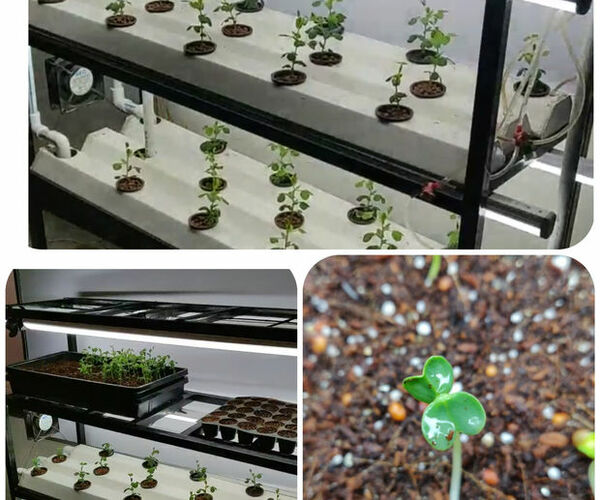
Indoor Hydroponic Vegetable Growing System
"Hello everyone, hope you all are doing good. In this instructable, i will make a indoor hydroponic system which will help us to grow various vegetables and fruits like, cherry tomato, spinach, lettuce, pea, etc. I will share with you all, what is in my mind in first step with few sketches, IDEAS I WILL IMPLEMENT 1) I will make a structure in which i will grow the vegetables vertically, one over another, so that i can multiply the production by 100 fold in that same area of land. 2) To start i will make 2 horizontal floors for hydroponic NFT systems and 1 floor to grow microgreens for my salad. 3) i Will test, How much energy will my system will consume and compare the electricity usage with the solar panels i have installed on my roof. So Lets get started with sketch......" [...]

Animated Word Clock
"Build your own Word Clock with a Matrix Animated display. This is a simple project uses an Arduino Nano, Color LEDs and includes a stylish 3D Printed Case. The Word Clock has three animated patterns- Matrix style - Typewriter Style - Rainbow Color The three buttons on the back enable animation style, color and time to be set. A great addition to your home office or work space and a great gift for others. " [...]
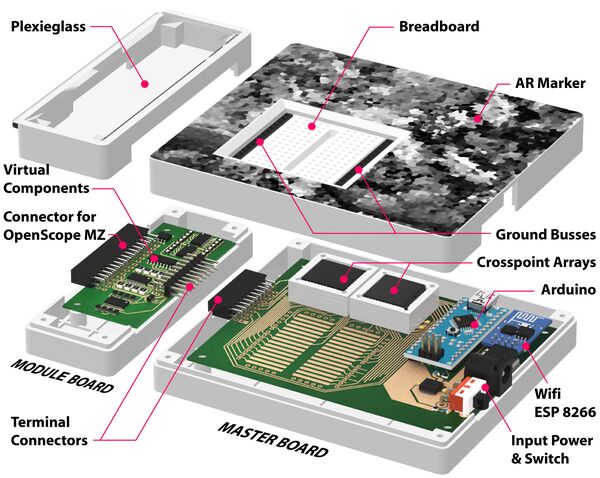
VirtualComponent
"Prototyping electronic circuits is an increasingly popular activity, supported by researchers, who develop toolkits to improve the design, debugging, and fabrication of electronics. Although past work mainly dealt with circuit topology, in this paper we propose a system for determining or tuning the values of the circuit components. Based on the results of a formative study with seventeen makers, we designed VirtualComponent, a mixed-reality tool that allows users to digitally place electronic components on a real breadboard, tune their values in software, and see these changes applied to the physical circuit in real-time. VirtualComponent is composed of a set of plug-and-play modules containing banks of components, and a custom breadboard managing the connections and components' values. Through demonstrations and the results of an informal study with twelve makers, we show that VirtualComponent is easy to use and allows users to test components' value configurations with little effort. For more information check the CHI 2019 paper: "VirtualComponent: a Mixed-Reality Tool for Designing and Tuning Breadboarded Circuits"." [...]

DIY RGB-LED Glow Poi With Remote Control
"Introduction Hello Everyone!This is my first guide and (hopefully) the first one in a series of guides on my quest to create an open-source RGB-LED visual poi. To keep it simple first, this is going to result in a simple led-poi featuring remote control via IR and all kinds of colour-change-animations. Keep in mind: This kind of poi (without IR-remote) can be bought for around 20$ on Amazon, so this is not worth the effort financially - DIY for the experience, not the result. I hope people will contribute animations to the GitHub of this project resulting in a great variety of animations for you to choose from and therefore giving this version some more value compared to the over-the-counter ones. DisclaimerFirst of all a few safety warnings. Only attempt this build if you know what you are doing." [...]
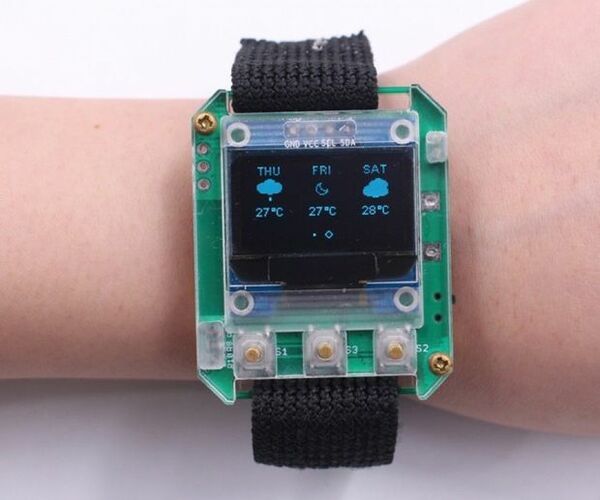
ESPWatch With Weather Forecasting
"The ESPWatch is based on ESP12 WIFI module, it gets the date/ time and the weather forecasting in few days from Internet server, and can also remote control the local instruments, such as Relay/LED/Fan. With this learning, you will learn the basic skill of components soldering/Arduino Programming/WIFI usage/Basic http protocol, the first& easy step to get into the electronic/programming world. There we also prepared simple case/watchband, so that you can get it works on your wrist within few minutes. " [...]

Arduino RC Robot
"Description A durable, 3D printed, remote controlled Arduino based robot with several hundred meters range. A modular quick-connect motor scheme lets you rapidly prototype different robot designs without any tools. Perfect for robotics education for kids. Whats it all about?So you've just started learning Arduino, or maybe 3D printing and your ready to build something cool. You want to build something meaningful, and practical, but fun... You're ready to build the OmniBot. If the Arduino is the Swiss Army Knife of electronics, then the OmniBot is the Swiss Army Kife of robotics!" [...]
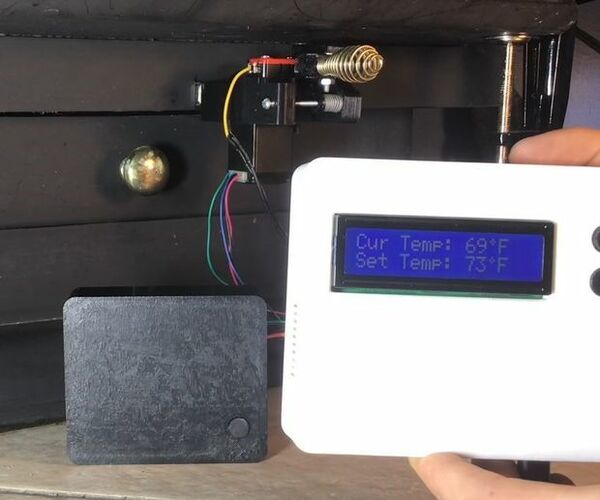
How to Make an Automatic Wood Stove Thermostat
"For my Mechatronics Class Project I decided to design and create an Automatic Wood Stove Thermostat using a WiFi enabled Arduino with a PID controller driving a Stepper motor to control the damper position on my Wood Stove. It has been a very rewarding experience and journey and I have learned a lot along the way! I would like to share the details of the project as well as how you can make/adapt it to your own application. I will provide a list of the supplies I used to create this controller along with any schematics and design files I used along the way. Supplies: 1 NodeMCU Board - For Driving Stepper and running PID Controller - Banggood EasyDriver Module Stepper Driver - Amazon NEMA 11 Stepper Motor - Amazon 1 Wemos D1 Mini Board - For Temperature Sensor and LCD Display - Banggood DHT11 Temperature and Humidity Sensor - Amazon 16x2 LCD Display - Amazon LCD i2c Adapter - Reduces number of LCD connection pins - Amazon 12V Power Supply - For Powering Easy Driver Various Resistors - Amazon PN2222A or Equivalent Transistor - Amazon Various Resistors 3 digital buttons - Amazon 1 Rectangular Neodymium Magnet - Amazon Circuit Boards - Gerber Files included - Use JLCPCB to Order - More Details Below Spring for Stepper Idler Pulley Tensioner Machine Screw for Tensioning Idler and Idler Shaft 3D Printed Components (STL's Included): Stepper Damper Controller Assembly Pulleys Stepper Controller Case Thermostat / Temperature Sensor Case Tools: Soldering Iron Screwdrivers Arduino Code: Provided in last step for programming the two microcontrollers. App: Blynk- This app is used to communicate between the temperature sensor and the damper controller and to be able to control the devices from the App." [...]

Arduino RGB Matrix Word Clock
"Forget numbers, the RGB LED Word Clock displays the time as text! Instead of two hands or a digital display, the Word Clock shows the current time as words in bright LED light using a standard 8x8 LED matrix. For example, if the time were 10:50 the LED clock would say IT IS TEN MINUTES TO ELEVEN. At 10:30 it would say IT IS HALF PAST TEN. Supplies:Hardware components: WS2812 LED 5050 RGB 8x8 64 LED Matrix for Arduino Wemos D1 Mini Pro M3 x 12mm Hex Socket Screws Bolts Software apps and online services:Arduino IDE Hand tools and fabrication machines: Glowforge - Laser Cutter or laser cutting service. " [...]
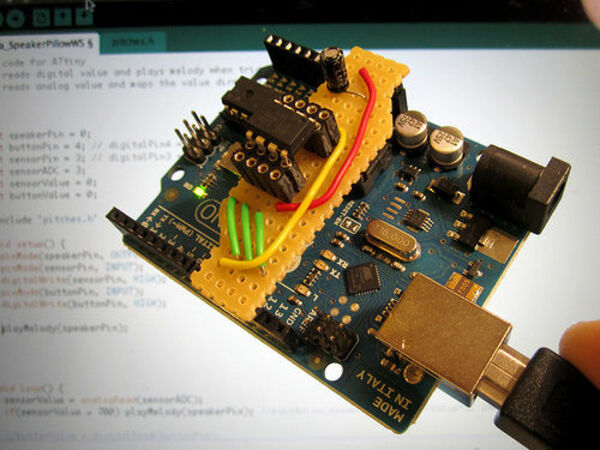
ATtiny Programming Shield for Arduino
"This little circuit sits nicely ontop of an Arduino board and lets you quickly plug in an ATtiny chip for programming using the Arduino "language" and IDE to write the code, and the Arduino board as an ISP programmer to upload the code to the tiny chip. These instructions are also published on our website titled HOW TO GET WHAT YOU WANT. For instructions on how to use Arduino to program ATtinies, please look at the following links. This Instructable will only explain how to build the programming shield. Arduino as ISP >> http://www.kobakant.at/DIY/?p=3742 Arduino board as ATtiny programmer (by Dave Mellis) >> http://hlt.media.mit.edu/?p=1706 Programming an ATtiny w/ Arduino 1.0.1 (by Dave Mellis) >> http://hlt.media.mit.edu/?p=1695" [...]

Magnetic LED Hexagons
"Welcome to my "LED Hexagon" lighting project, interconnecting light up hexagons. Lately I've seen a few different versions of these lighting projects hitting the market but they all have one thing in common... the price. Each hexagon here costs just a few dollars and doesn't sacrifice on the quality or features of the ones available on the market! In addition they are highly customizable and not restricted to just my hexagon shape. View my video here for help with setup I'll do my best to explain each part here. Features: Easy magnet connection Simple easy design Simple circuit Customizable layout Customizable led pattern Low cost per hexagon" [...]
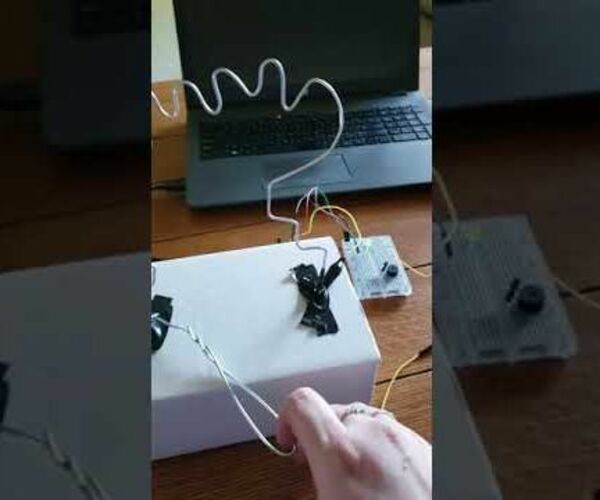
Buzz Wire Game With LED Timer for Arduino UNO
"This buzz wire game allows the user to challenge their steady hand against the LED timer. The goal is to get the game handle from one side of the maze to the other without touching the maze and before the LED turns off. If the game handle and the maze do touch a loud buzz is emitted from the piezo. The idea for this game came from a favorite childhood game, Operation, my students love for a challenging puzzle, and FABLABJubail's buzz wire game. This project is great for beginning Arduino users who are familiar with the basics of coding. Materials and tools needed: 1 Arduino Uno 1 Breadboard 1 USB Cable 1 Piezo Buzzer 1 LED Light 1 560 Ohm Resistor 4 Long Jumper Wires 1 Short Jumper Wire 2 Alligator Clip Jumper Wires (1 male/1 female) Aluminum Wire Pliers Wire Cutters 1 Small Box Electrical Tape" [...]

Recreating the Worlds Hardest Game on the Arduino
"This project is based off of a computer game that you can find online. Its name is, "The Worlds Hardest Game." I was able to re-create it on the Arduino using a four module LED Matrix. In this instructable I teach you how to construct it yourself. Before we get into to too many details I want to give a quick overview of the steps I went through to create this game. I gathered all the parts needed." [...]
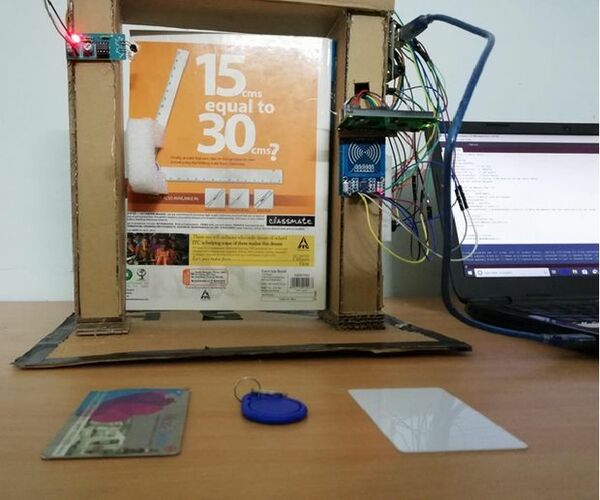
Access Control System Using RFID
"The project that i have made is a RFID door lock at an affordable price. The goal of this project is to create a more convenient way to unlock your door than the traditional key. In the keys place is an RFID tag that will unlock the door by proximity. However, the improvements of this RFID door lock must outweigh the complications of implementation. The design consists of two components. The first component is the actual door lock that must be installed in the doorframe." [...]
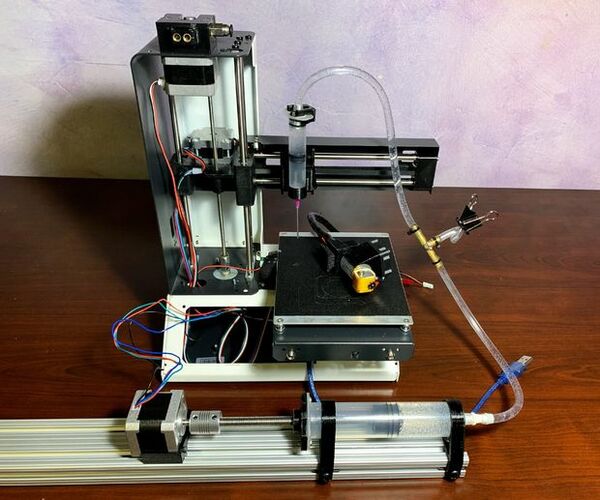
Low Cost Bioprinter
"The goal of this project is to develop a low-cost bioprinter to make bioprinting more accessible to research institutions. Currently, low-end bioprinters cost approximately $10,000 while high-end bioprinters cost approximately $170,000. In contrast, our printer can be built for approximately $375. Supplies: Parts: Ramps 1.4: https://www.amazon.com/HiLetgo-Control-Printer-Su... Arduino mega 2560: https://www.amazon.com/Elegoo-EL-CB-003-ATmega2560... Stepper motor drivers: https://www.amazon.com/BIQU-Compatible-Stepper-Ste... Additional stepper motor (optional) https://www.amazon.com/Stepper-Motor-Bipolar-64oz-... Maker beam 2 in X 1 in Maker beam attachment hardware M3 screws assorted sizes M3 nuts x2 8 mm threaded rod 8 mm nut 608 bearing Binder clip Filament Monoprice V2 https://www.monoprice.com/product?p_id=15365&gcli... Zip ties M3 heat set nuts 2mm width Tools: Drill bits of various sizes Hand Drill Drill press Hacksaw Soldering iron + solder Wire stripper Needle nose pliers Hex keys various sizes Lab supplies: Petri dishes ~70mm diameter 60 ml syringe with Luer-lock tip 10 ml syringe with Luer-lock tip Luer-lock fittings Tubing for fittings T Connector for tubing Centrifuge Centrifuge tubes 60ml Scale Weigh boats Autoclave Beakers Graduated cylinder 0.1M CaCl2 solution Agarose Alginate Methylcellulose Sucrose Software: Fusion 360 or Solidworks Arduino IDE Repetier Host Ultimaker Cura 4" [...]
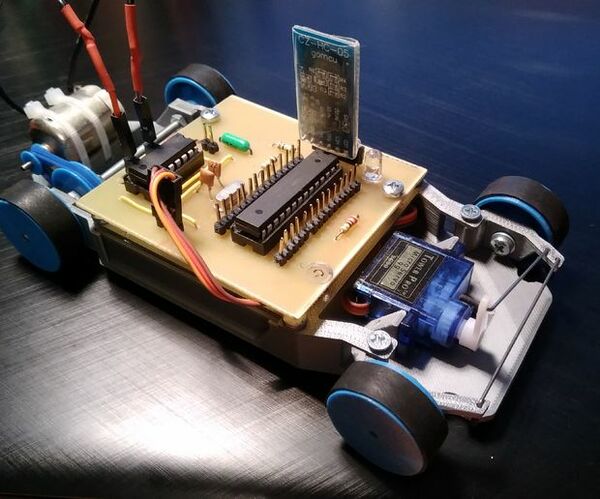
Project Small Car
"This car was made as a creative activity for students from Erazmus project. The Small Car celebrated big succes. So I've decided to share this small, unassuming and yet very educative project with community. It's ideal to entertain students, for instance during public open day at schools. This project will help students master their 3D printing skills, PCB making skills, constructing skills and programming skills. And the best bit is price which can be pressed under 15 dollars for one car." [...]
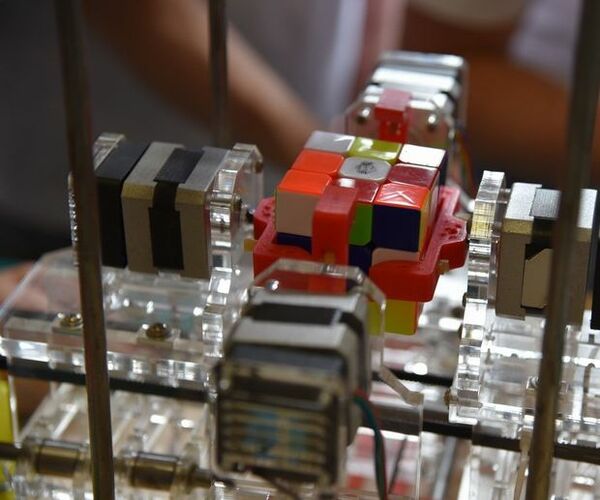
ARS - Arduino Rubik Solver
"ARS is a complete system to solve Rubik's cube: yes, another robot to solve the cube! ARS is a three years long school project made with 3D printed parts and laser cut structures: an Arduino receives the correct sequence generated by an home made software, ARS Studio, through USB port, then moves forward and backward six stepper motors till the end. ARS is based on great mr. Kociemba algorithm: as told on his website, Herbert Kociemba is a German cuber from Darmstadt, Germany who invented this algorithm in 1992 in order to find near optimal solutions to 3x3 cube, improving on the Thistlethwaite Algorithm. In this Instructable instructions will be explained about building robot structure, and using the open source software developed to generate the proper sequence needed to solve the cube using Kociemba's algorithm. More infos on Kociemba and his work: about algorithm about God's number, the number of moves an algorithm would take in the worst case to solve the cube. At long last, God's Number has been shown to be 20 by Kociemba and his friends an interview to Herbert Kociemba info about Kociemba's software, from whis ARS Studio comes from Following steps will deal on mechanical structure and software use." [...]
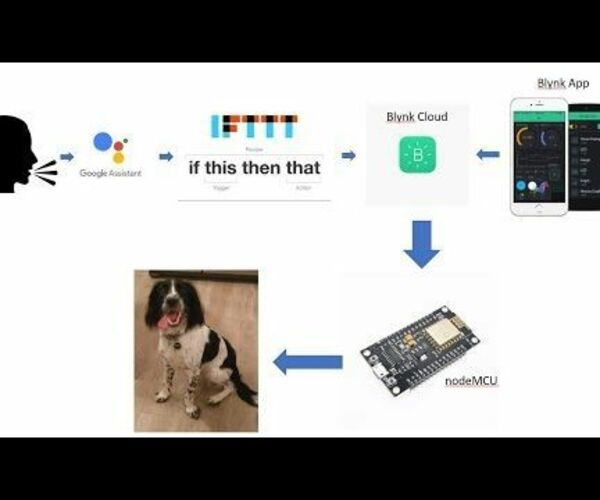
IoT Laser Pet Toy
"From time to time, my kitchen falls victim to a bored dog. When left unattended, skirting boards, dog beds, kitchen towels, kitchen cabinets and paintwork have all suffered. To help keep my pupper entertained while I'm at work, I developed an IoT laser pet toy to keep him occupied. In the auto mode, a laser will move around the floor in a random pattern for a period of time, after which treats are dropped to reward the pet. The reward is important so they don't get frustrated by the elusive laser and it encourages them to play! It can be controlled manually via a smartphone, or set to auto mode." [...]
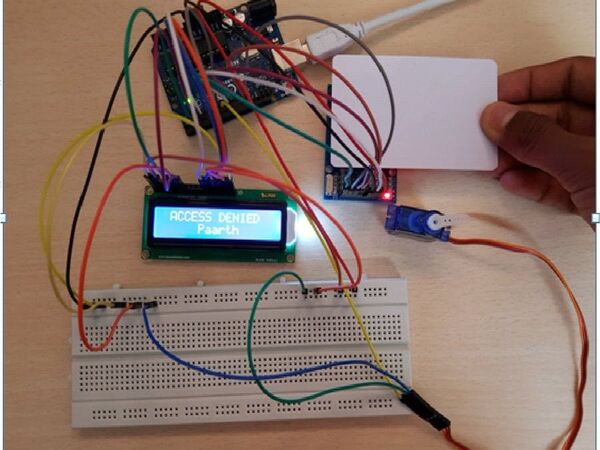
RFID Door Lock System
"Using RFID card you can lock or unlock your door. The arduino based RFIDdoor lock system is secure and responsive as compared to other systems. Withthe use of arduino, it becomes much easy to design. Program a code and uploadit to arduino just like a plug and play device. It is simple and cost efficientproject and can be used as a basic access control mechanism. Their main advantageis contactless communication and RFID tags can work in any environmentalconditions." [...]

Mastermind Star Wars With Arduino MEGA
"These are adverse times for rebellion. Although the Death Star has been destroyed, the Imperial troops are using free hardware and Arduino as a secret weapon. That is the advantage of free technologies, any person (either good or bad) can use them. In a hidden base located on the planet Anoat, they are building a 3D printer capable of replicating Imperial Destroyer. The only solution to defeat the Empire is that a group of rebels commanded by Luke Skycuartielles and Obi-Wan Banzi, defeat the imperial troops and get the key that will give access to the plans to destroy the secret weapon. This key consists of 4 colors and you have 10 attempts to get it deciphered." [...]

Green House Automation
"Green house automation is a project where three parameters of a green house, i.e. Soil Moisture, Temperature & Humidity, are monitored by the user remotely simply by using a web browser. Some essential components required are listed below 1. Raspberry PI Model B 2. NodeMCU Development Board 3. ESP8266 Wifi module 4." [...]

Nixie Clock YT
"Hi everyone, this is my new nixie clock. It is my version 2.0 The first model isn't on instructables. you will see picture later. Almost the same. Difference is, no leds, some parts are in a dip package and as well board is more larger. So this is my new surface mount version." [...]
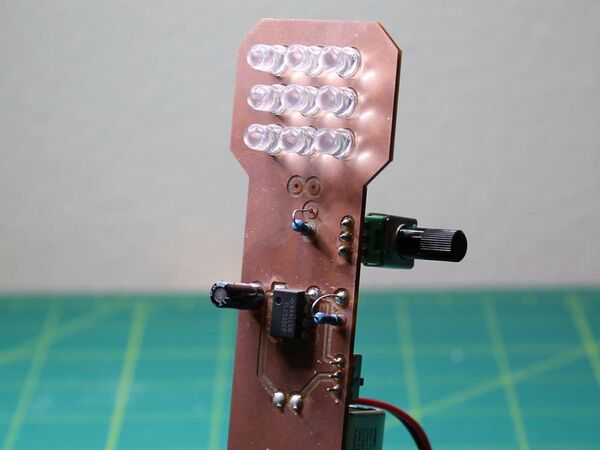
Handheld Party Starter Pocket Strobe
"A 555 timer circuit with a 10k potentiometer and 9 LEDs for those times you just want to kick it up a notch. Bridging out from my last post on the 555 timer LED Blinkie, I decided to make something a bit more exciting. I had an idea for a pocket strobe light/flashlight I wanted to build with an adjustable potentiometer. It’s a variation on my original 555 Timer Blinkie Circuit but with a potentiometer that allows you to adjust the frequency of the blink, giving you a strobe like effect. Ideally I’d like to make a version that responds to sound with a sensor but manual input works for now. Our 555 timer circuit today utilizes the astable operating mode with a 10k potentiometer to adjust the speed of the flash." [...]

Real-Time SD Card Failure Detection System
"In this project, you'll learn how to create a system that must be able to detect a malfunction in an SD card and to inform on an LCD. On some systems, such as 3D printers, memory cards are used to save print files. Therefore, it is very important to check the memory card connection at the beginning and during the printing process. Therefore, in case of any connection or card failure, the system must be able to detect a malfunction and inform the user on the system LCD screen. In addition to the 3D printer, this method can be used for any system or device that uses a memory card. Therefore, we present a circuit to test the solution, as shown in Figure 1." [...]

Perpetual Motion Davinci Style II
""Perpetual Motion Davinci Style II" is an updated version of my original implementation of Mr. Davinci's "overbalanced wheel" design over five years ago. In this updated version, "perpetual motion" begins when the model is tilted backwards causing a magnet to activate a reed switch which in turn activates a motor that turns the overbalanced wheel. And "perpetual motion" ends when either the battery expires, the rubber band breaks, the motor gives out, or by simply tilting the model forward and tapping on the back near the reed switch to disengage the magnet. In other words, like the original, it's just an illusion. The motor I used in the final design was a 30 RPM gear motor, however, I've used 150 RPM motors with success, they just spun too fast for my taste. As usual, I probably forgot a file or two or who knows what else, so if you have any questions, please do not hesitate to ask as I do make plenty of mistakes." [...]
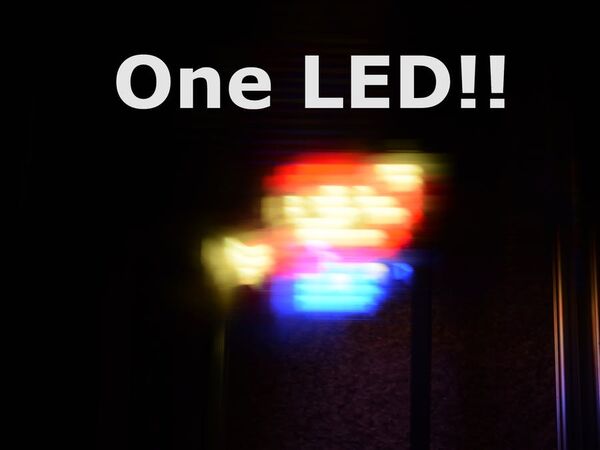
Creating Images Using One LED
"Use the concepts in light painting to create a machine that can recreate bitmaps with a long-exposure camera using a single LED. After watching several videos and seeing numerous articles about light painting, I decided to give it a try. Light painting involves using a camera with a very long exposure time to capture a small light source. This allows for a single of light to become strung out to a long streak in a single image. But what if someone wants to create a more detailed picture or use many different colors? This is how I came up with the idea to build a 2-axis CNC machine that has a single RGB LED that can change color and “paint” and image." [...]
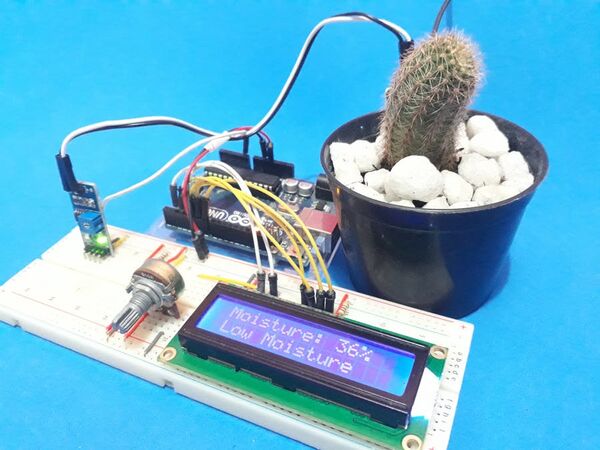
Moisture Measurement System with Alert
"You'll learn how to create a system to monitoring the soil moisture level of the plant and inform at the users to irrigate the plant. In several residences, it is common to find jars with different types of plants. And with the great number of day-to-day activities, people forget to water their plants and they end up dying for lack of water. As a way to avoid this problem, we decided to create a system to inform when a plant has no water. In this way, you will never forget to irrigate your plant and it will stay alive for a long time. Next, we will present the whole development of this project." [...]
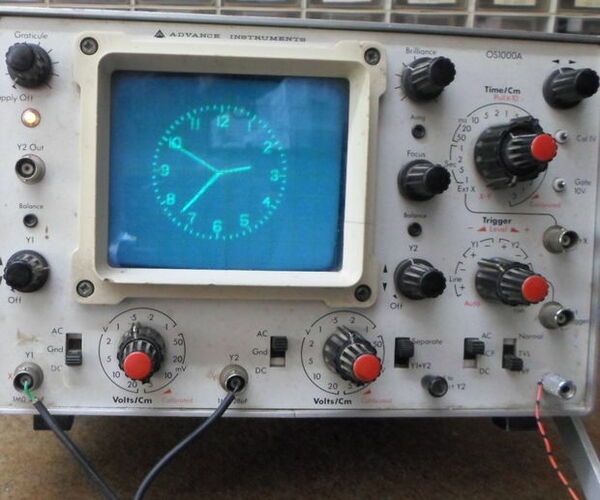
Extremly Simple Oscilloscope Clock With ESP32
"How to turn your old oscilloscope into an analog clock. " [...]
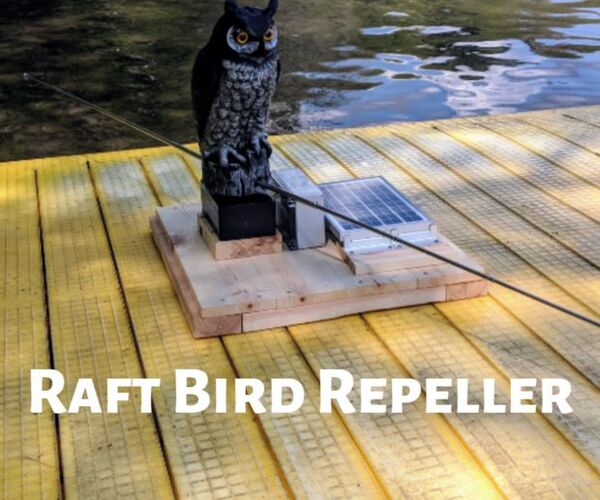
Raft Bird Repeller
"In this project I will show you how to build a solar-powered Raft Bird Repeller that will get rid of those pesky birds that poop on your raft. " [...]
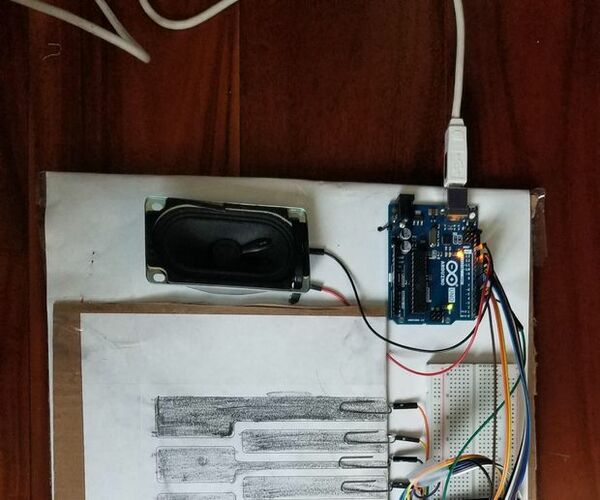
How to Make an Cheap Touch-Capacitive Piano
"I'm a big fan of technology and music, and I decided to make this after I was inspired by my former life as a piano student. Anyways... In this lesson, I'll show you how to make a cheap capacitive touch piano using an Arduino, speaker, and paper. I will show you step-by-step instructions to make this and how to connect the wires. In the end, you will have made your very own capacitive touch piano with 8 keys. Let's get started!" [...]
That's all Folks!


